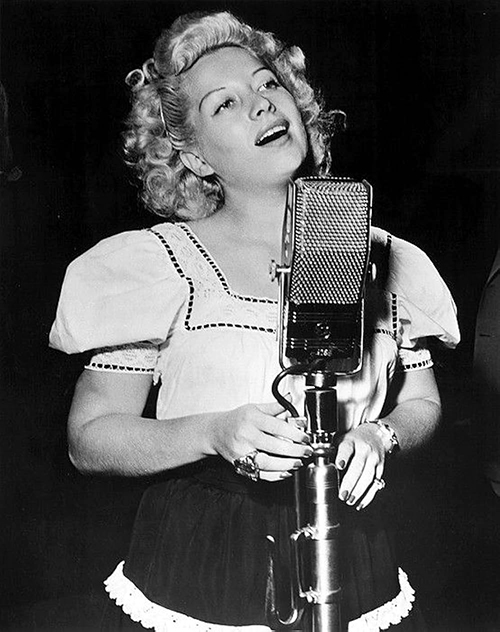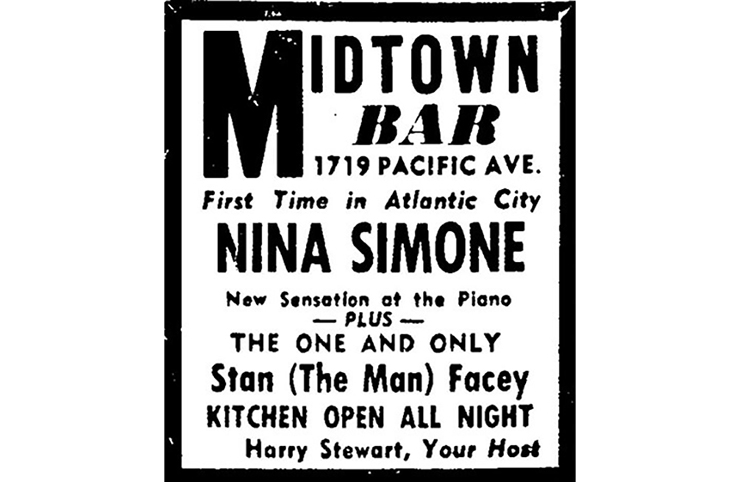By Bruce Klauber
When the subject is Atlantic City history, several things come to mind: The Boardwalk, rolling chairs, the beach, salt water taffy, the Miss America Pageant, gambling casinos, and the diving horse. Atlantic City is not particularly known as the birthplace of future stars of jazz. However, when looking more closely at the record, Atlantic City was the birthplace of several certifiable legends of jazz, and even more were nurtured by “The Queen of Resorts.”
The story of the “discovery” of future jazz trumpet legend Clifford Brown by Quincy Jones and Lionel Hampton, during Brown’s summer tenure at Atlantic City’s Club Paradise, has been detailed previously in a Shore Local column. In addition to Brown, probably the most famous case in point of a future star whose career was born in Atlantic City is that of singer and pianist Eunice Kathleen Waymon, better known to one and all as Nina Simone.
Though born in North Carolina and educated classically, albeit briefly, at the Juilliard School of Music in New York City, one of Simone’s first professional jobs as a pianist was at an Atlantic City bar on 1719 Pacific Ave. called the Midtown Bar & Grill. She had just turned 21 and was hired in June of 1954, solely as a pianist.
After a night or two, the Midtown’s owner made it clear that if Waymon didn’t sing and play she’d be out of a job. As the story goes, her singing was a success, her salary was upped to $90 a week, and that summer she changed her name to Nina Simone.
Those were not easy times. Atlantic City, in 1954, was still segregated. In her 1991 autobiography, “I Put a Spell on You,” Simone described the place as “a seedy little bar where old guys go to huddle over a drink and fall asleep.” Still, a star was born there.

Helen Forrest
Big band vocalist Helen Forrest, best known for her work with the orchestras of Harry James, Artie Shaw and Benny Goodman, was born in Atlantic City in 1917. She moved to Brooklyn as a teen, and then moved back to the shore where she got her pro start in a band led by her brother.
She returned to the New York City area when she was around 17 years of age, sang on area radio stations for a few years, and was finally “discovered” by mercurial bandleader Artie Shaw.
Forrest had difficult shoes to fill, as she replaced Billie Holiday in the Shaw band. Forrest had the distinction of working with three of the big band era’s most popular ensembles—James, Goodman, and Shaw—and was voted by Down Beat magazine as the nation’s top vocalist in 1941 and 1942.
After the big band era was over, her profile dimmed, but she did work intermittently as a soloist. She was working with the “ghost band” of Tommy Dorsey, led by saxophonist Sam Donahue, in December of 1963, the night that the Dorsey band’s male singer, Frank Sinatra, Jr. was kidnapped. Forrest passed in 1999.
Drummer Buddy Rich is often recalled as an electrifying big band drummer who drove the bands of Artie Shaw, Tommy Dorsey and Harry James, as well as his own swinging bands from 1966 through 1983. However, Rich led a remarkable series of small groups over the years, with the most extraordinary of all being the combo he led from around 1959 through 1962 that featured Mike Mainieri on vibraphone and Atlantic City native Sam Most on flute.
Given that the relatively gentle instrumentation of flute and vibes seemed an unlikely one for a Buddy Rich group, it still worked, thanks to Mainieri and thanks to Most.
Most, often regarded as the “first jazz flutist,” was born in Atlantic City in 1930. He didn’t spend a lot of time at the shore. He was already on the road with various bands, including those led by Tommy Dorsey, Boyd Raeburn, and Shep Fields when he was just 18. He evolved quickly into a first-rate jazz improviser, and recorded his first outing as a leader when he was 23.

Most, who passed in 2013 at the age of 82, was the subject of a fine documentary which did not get the attention it deserved — Edmond Goff’s film, “Sam Most: Jazz Flutist.”
While the bebop era was arguably among the most innovative periods for jazz in musical history, that pivotal period of time, roughly 1945 to 1955, sadly produced its share of tragic figures. Drugs ultimately brought down legends like Charlie Parker, Fats Navarro, and Sonny Berman; and greatly affected the lives and careers of many others, including the relatively obscure jazz pianist, Joe Albany.
Albany, born in Atlantic City in 1924, had already turned pro at age 19 and moved to the West Coast to work with Benny Carter’s orchestra. Though he worked with icons like Miles Davis and Lester Young through the years, he struggled with drug addiction for decades. He cleaned up to an extent and made a comeback in the 1970s. Albany’s legend grew after his death in 1988 at the age of 63.
He was the subject of a documentary film, “Joe Albany: A Jazz Life,” drawn from a book written by his daughter called “Low Down: Junk, Jazz and Other Fairy Tales from Childhood.” “Low Down” was adapted for the motion picture screen. Reviews were mixed for the little-seen film, which was released briefly in 2014.
Gene Quill was a swinging, first-rate alto saxophonist who was only 15 years old when he joined the Atlantic City Musicians Union, Local 661, in 1943. The Atlantic City native was already leading his own band, playing Army bases and USO dances, while still in high school. Upon graduation, he joined Alex Bartha’s “house band” at the Steel Pier.
His career as a leader, sideman, and recording artist was long and impressive. His most well-known recordings—six of them, in fact — were made in tandem with fellow alto saxophonist Phil Woods. After touring the world more than once, Gene Quill moved back to Atlantic City in 1974 to join the remains of the Steel Pier house band, then called the “Steel Pier Show Band.”
Tragically, he was mugged while walking home from work on Memorial Day weekend in 1977, which left him paralyzed on his right side and blind in one eye. Two years later, he was well enough to resume playing on a very limited basis, but he spent the rest of life living in Pomona in relative obscurity until his death in 1988 at the age of 60.
Swing-era trumpet star Ziggy Elman was born as Harry Aaron Finkelman, in Philadelphia in 1914, but his family moved to Atlantic City when Finkelman/Elman was 4 years old. Growing up at the shore, he briefly played violin and trombone, but finally decided on the trumpet.
As “Ziggy Elman,” he joined Alex Bartha’s big band at the Steel Pier in 1936. His tenure in Bartha’s ensemble didn’t last long. Benny Goodman heard him with Bartha and hired Elman immediately (Goodman, along with many other name band leaders who appeared at the Steel Pier, often raided Bartha’s band for talent). With Goodman, Elman had a gigantic hit, circa 1939, with “And the Angels Sing.”
Offered a better deal by Tommy Dorsey, Elman spent 1940 to 1943 with the “Sentimental Gentleman of Swing,” and again in 1946. Unfortunately, the years were not kind to this man, whose individual style was instantly identifiable, after the big band era. While he did appear on-camera in “The Benny Goodman Story” movie of 1956, recreating his solo on “And the Angels Sing,” Elman wasn’t well enough to do the actual playing. Mannie Klein played trumpet on the soundtrack. Ziggy Elman died in 1968 at the age of 54.
Just announced: Early bird passes have just gone on sale for one of the East Coast’s finest jazz festivals, The Cape May Exit Zero Jazz Festival. This year, the dates are April 19 to 21. Most of the shows will take place at Cape May’s Convention Hall, and artists announced thus far include saxophone icon Brandford Marsalis, and young keyboard wizard Joey Alexander. For more information and tickets, visit www.exitzerojazzfestival.com/
Bruce Klauber is the author of four books, an award-winning music journalist, concert and record producer and publicist, producer of the Warner Brothers and Hudson Music “Jazz Legends” film series, and a working jazz drummer and vocalist since childhood. He served as Technical Adviser on the Oscar-winning film, “Whiplash,” and on the 2018 Mickey Rourke film, “Tiger.” He has been honored by Combs College of Music and Drexel University for his “contributions to music journalism and jazz performance.”
















